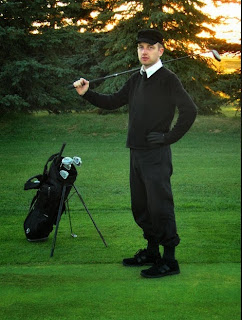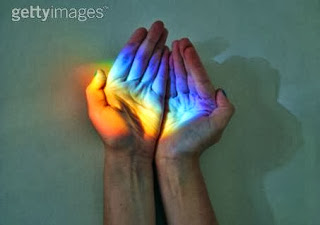Line- marks made by a pointed tool: brush, pencil, pen, etc. Lines can vary in width, direction, curvature, length, or color.
I chose this photo because the are easy to see in the desert.
This painting shows the line right there on the pitch fork and the house on the back of them.
Shape formed wherever the ends of a continuous line meet. Geometric shapes such as circles, triangles or squares have perfect, uniform measurements and don't often appear in nature. Organic shapes are associated with things from the natural world, like plants and animals.
I chose this photo because the bubbles come out in different shapes instead of a circle.
This painting shows shapes on the far right.
Color- the primary colors, secondary colors, and the tertiary (intermediate) colors. They also show the relationships between complementary colors across from each other, such as blue and orange; and analogous (similar or related) colors next to each other such as yellow, green, and blue. Black and white may be thought of as colors but, in fact, they are not. White light is the presence of all color; black is the absence of reflected light and therefore the absence of color.
I chose the photo because it shows the the bright color on the persons hand.
This painting shows a lot of bright and dark color in this painting.
Value (Tone) -
refers to dark and light; the value scale refers to black and white with all gradations of gray in between. Value contrasts help us to see and understand a two-dimensional work of art.
I chose this photo because it shows bight color as lights, and dark for night.
This painting shows shaded parts which are dark and light shade as the light color in the paining.
Form -
describes objects that are three-dimensional, having length, width, and height.
I chose this photo because a cube is three dimensional and has length, width, and height.
This painting shows three dimensional every where in the middle of the painting.
Texture -be rough, bumpy, slick, scratchy, smooth, silky, soft, prickly--the list is endless. Texture refers to the surface quality, both simulated and actual, of artwork.
For this photo it shows some rough and smooth texture.
This painting has rough, bumpy surfaces or texture.
Space distances or areas around, between, or within components of a piece. Space can be positive (white or light) or negative (black or dark), open or closed,shallow or deep, and two-dimensional or three-dimensional.
This shows dark and shallow in the middle and the sides.
This shows light on the left and on the right side and not in middle and it is negative only the middle is missing in this painting.
Balance is the comfortable or pleasing arrangement of things in art. There are three different types of balance: symmetrical, asymmetrical, and radial. The human figure is symmetrically balanced; the same on the left and right side. The tree is asymmetrically balanced; its branches are not distributed equally on each side, but their total weight is balanced left and right. The sun is an example of radial balance; all its rays are equal in length from the center.
The rocks balance each other on each side and both sides have the same weight to hold it from falling.
The fish and the birds in this painting are equal from top to bottom and have the same the number of in each slot.
Contrast is created by using elements that conflict with one another. Often, contrast is created using complementary colors or extremely light and dark values. Contrast creates interest in a piece and often draws the eye to certain areas. It is used to make a painting look interesting.
In this photo you have light and dark colors with the help of the widow.
This picture shows the light and dark color designs in this painting and shows values to catch viewers eyes.
Emphasis in the focal area of an artwork gives it importance. An artist may stress some elements of the design over others. The eye of the viewer will focus on the area of emphasis or center of interest first, then take in the rest of the composition.
The picture shows colors that attract the viewers eyes.
The colors are very bright and make its very appearing to the painting and makes the viewers eyes focus on the painting more.
Movement in an artwork means the artist is taking viewers on a trip through the work by means of lines, edges, shapes, and colors often leading to the focal area. Movement is a visual flow through the composition. It can be the suggestion of motion in a design as you move from object to object by way of placement and position. Directional movement can be created with a value pattern. It is with the placement of dark and light areas that you can move your attention through the format.
Two objects are moving and a pattern of the color is fading away as the object moves which are dark colors.
The people here in this painting represent movement and as they are in different spots they seem to being moving to place to place.
Pattern are made in art when the same shapes or elements are repeated again and again. Pattern uses the elements of art in planned or random repetitions to enhance surfaces of paintings or sculptures.
The swirl in the photograph repeated its self again, again, and again until it reaches the bottom of the ground.
The painting pattern does it over and over and over again and it still is the same pattern it does singe over time.
Rhythm is the repetition of shapes, lines, and forms. Rhythm is a movement in which some elements recurs regularly. Like a dance, it will have a flow of objects that will seem to be like the beat of music.
The square and the big square are have rhythm in shape: little to big squares.
This pattern has rhythm to it if you follow the colors movement in the panning.
Unity means that all elements in an artwork are in harmony. Unity brings together a composition with similar units. For example, if your composition was using wavy lines and organic shapes you would stay with those types of lines and not put in even one geometric shape.
I chose this photo because it shows a pattern or a shape in the buildings and they stay same way and not change the shapes int he building.
In this painting the artiest does not change the shapes and stays with the shapes that he/she have used in the painting.





















































.jpg)


















